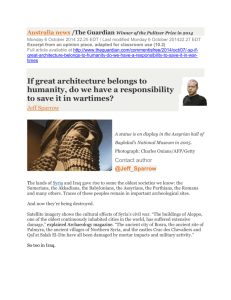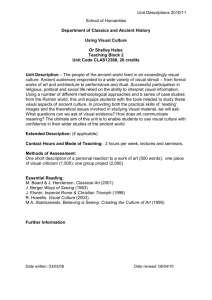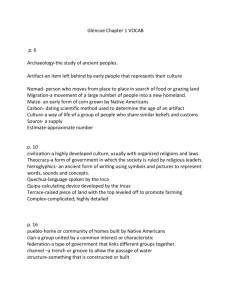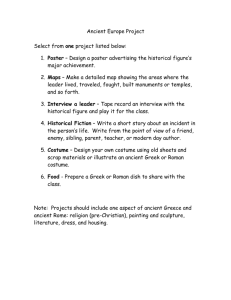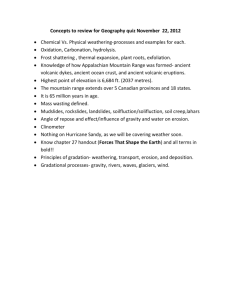File
advertisement
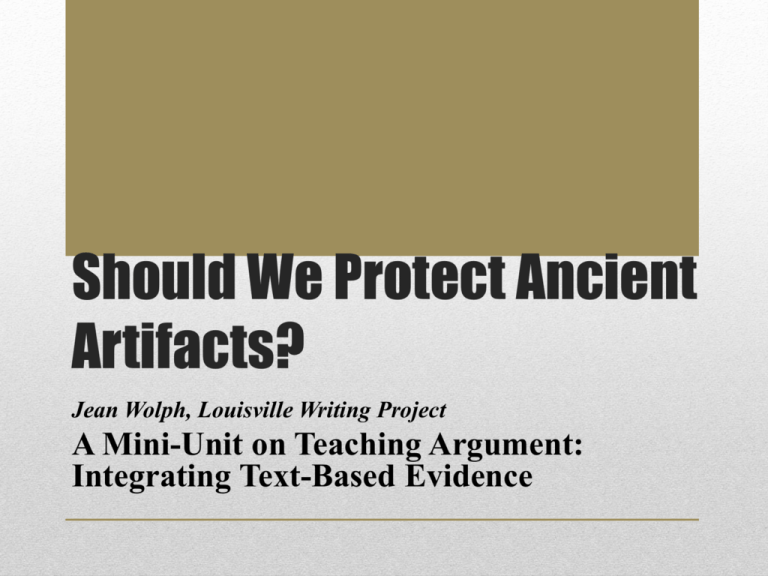
Should We Protect Ancient Artifacts? Jean Wolph, Louisville Writing Project A Mini-Unit on Teaching Argument: Integrating Text-Based Evidence Mini-Unit Overview Writing Argument MINI-UNIT Emphasis ARGUMENT SKILLS PRODUCT ELEMENTS OF ARGUMENT Reading CLOSE READING STRATEGIES RESPONSE TO READINGS Close reading strategies Writing & talking to develop knowledge on topic or issue TOPICS # of Lessons Draft, Feedback, Revise, Reflect Integrate evidence from multiple sources to support a claim 3 Lessons Entering Skills: • Notetaking • Annotating text • Identifying evidence (quotations, facts, and statistics) to support the claim • Citing sources Foundational Skills: • Integrate evidence from several sources to support a claim Product: Draft with revision to integrate facts from other sources Peer Review Claim Evidence Coding text Partner share Should We Protect Ancient Artifacts? 2 video texts 1 print text 2 Grades 6-8 Social Studies Writing Standards Emphasized in the Mini-Unit Write arguments to support claims with clear reasons and relevant evidence. b.Support claim(s) with…relevant evidence…demonstrating an understanding of the topic or text. Mini-Unit Sequence Day 1 View Priceless Iraqi Artifacts Destroyed by ISIS / THU, FEB 26 Record facts and key words. Partner Talk View clip from the movie The Monument Men Write a response to the clip. Partner Talk Class Discussion Day 2 Read excerpt from “If great architecture belongs to humanity, do we have a responsibility to save it in wartimes?” by Jeff Sparrow Code the article. Mark compelling facts and key words. Partner Talk Write: Should we protect the rights of the dead when we cannot guarantee the rights of the living? Day 3 Peer Review: Where could we add facts from Day 1 videos? Revise to add additional evidence. View this video: Priceless Iraqi Artifacts Destroyed by ISIS / THU, FEB 26 http://www.nbcnews.com/nightly-news/video/priceless-iraqiartifacts-destroyed-by-isis-405129795627 We’ll watch it twice, recording facts and key words as we view. See next slide. Text #1 Record what you observe, including facts and key words. FACTS Writing #1 KEY WORDS In pairs, share what you thought was important from the video and from your writing and notes. Add to your notes after sharing. Partner Talk During World War II, the Nazis steal countless pieces of art and hide them away. Some over-the-hill art scholars, historians, architects and other experts form a unit to retrieve as many of the stolen masterpieces as possible. The mission becomes even more urgent when the team learns about Hitler's "Nero Decree," which orders destruction of the artworks if the Third Reich falls. Caught in a race against time, the men risk their lives to protect some of mankind's greatest achievements. --The Monuments Men, Film synopsis, www.bookrags.com View this clip from the movie The Monuments Men: <iframe width="560" height="315" src="https://www.youtube.com/embed/ZDTT44VIFHE" frameborder="0" allowfullscreen></iframe> Text #2 Write a response to the movie clip. • What did you think? • What questions do you have? Writing #2 In pairs, share what you thought about the movie clip. Share your questions and try to puzzle out answers. Prepare to share your ideas with the class. Partner Talk Read the excerpt from “If great architecture belongs to humanity, do we have a responsibility to save it in wartimes?” by Jeff Sparrow. Highlight or code the article by marking compelling facts and key words. Text #3 Australia news /The Guardian Winner of the Pulitzer Prize in 2014 Monday 6 October 2014 22.25 EDT / Last modified Monday 6 October 201422.27 EDT Excerpt from an opinion piece, adapted for classroom use (10.2) Full article available at http://www.theguardian.com/commentisfree/2014/oct/07/-sp-if-greatarchitecture-belongs-to-humanity-do-we-have-a-responsibility-to-save-it-in-war-times If great architecture belongs to humanity, do we have a responsibility to save it in wartimes? by Jeff Sparrow The lands of Syria and Iraq gave rise to some the oldest societies we know: the Sumerians, the Akkadians, the Babylonians, the Assyrians, the Parthians, the Romans and many others. Traces of these peoples remain in important archeological sites. And now they’re being destroyed. Satellite imagery shows the cultural effects of Syria’s civil war. “The buildings of Aleppo, one of the oldest continuously inhabited cities in the world, has suffered extensive damage,” explained Archaeology magazine. “The ancient city of Bosra, the ancient site of Palmyra, the ancient villages of Northern Syria, and the castles Crac des Chevaliers and Qal’at Salah El-Din have all been damaged by mortar impacts and military activity.” So too in Iraq. Sometimes, the destruction is accidental (if that term means anything in wartime). Sometimes it’s deliberate, with the Islamic State leveling ancient religious sites. After looters attacked Baghdad’s National Museum in 2003, Francis Deblauwe started the (now defunct) Iraq and Archaeology site. He wrote: War in this cradle of civilization … inevitably takes its toll on the archaeological heritage as well. After all, this fertile flood plain and surrounding mountains gave birth to agriculture, to writing, to cities, to laws, to the 24 hours in a day, and many more things we take for granted. A beheaded looted sculpture in Iraq's archeological museum in Baghdad. Photograph: Patrick Baz/AFP/Getty Iraq takes its name from Uruk. Uruk was the ancient city said to have been ruled by Gilgamesh, sometime between 2,500 and 2,700 BC. In the epic poem that bears his name, Gilgamesh leaves Uruk. He had built Uruk. But he was grieving the death of his friend. After many adventures, he accepts that only the gods endure forever. He then returns to Uruk with new appreciation. A city is a human achievement. It offers the only immortality humans can expect. David Ferry’s translation describes Uruk as follows: The outer wall shines in the sun like brightest copper; the inner wall is beyond the imagining of kings. Study the brickwork, study the fortification; climb the great ancient staircase to the terrace; study how it is made… Uruk’s ruins were rediscovered in the 19th century, 250kms south of Baghdad. That means we can study the brickwork, the fortifications and the outer walls Gilgamesh once saw. When we do, we are met with the same questions about eternity he pondered 4,500 years ago. The ancient stones show the persistence of our culture. Preserving culture, as the poem suggests, is our only comfort for the fact that we all will die someday. That’s why, in The Seven Lamps of Architecture, Victorian art critic John Ruskin argues that we have a responsibility to such artifacts. He warns: They are not ours. They belong partly to those who built them, and partly to all the generations of mankind who are to follow us. The dead have still their right in them: that which they labored for, the praise of achievement or the expression of religious feeling, or whatsoever else it might be which in those buildings they intended to be permanent, we have no right to obliterate. Great architecture, Ruskin says, belongs to humanity as a whole. It does not belong to “those mobs who do violence to it”. It’s an argument that surely applies to the relics of ancient Mesopotamia, caught between Islamic State fighters and US strike bombers. But can we – or, rather, should we – protect the rights of the dead when we cannot guarantee the rights of the living? Nearly 200,000 people have already died in Syria’s civil war. Estimates of deaths from the 2003 Iraq invasion vary from several hundred thousand to over a million. In the midst of unimaginable blood and suffering, is it wrong to care about the walls of Uruk? “I wish to be absolutely clear,” writes Deblauwe, “no epic Sumerian cuneiform tablet, majestic Neo-Assyrian lamassu sculpture or any other Mesopotamian artifact is worth a human life, be it Iraqi, American, British or other.” The bluntness of that statement, from a man who deeply cares about Sumerian cuneiform tablets, contrasts with Ruskin’s comments. He champions the past over the flesh and blood of today’s people. He privileges a bygone world over the one in which we actually live. There’s a long, disgraceful tradition of revering the ancient world while belittling anyone with the nerve to live in those cities today. When cultural treasures were seized from “lesser” populations it was often on the basis that the ignorant locals couldn’t appreciate the stuff’s value. That’s how major British museums built their collections, from the Elgin Marbles to the bones of Aboriginal people. Yet it’s worth thinking about the need for such actions. In pairs, share what you thought was important from the article. Add to your coding or highlighting of important facts and key words as you share. Partner Talk WRITE: What do you think? How important are ancient artifacts and monuments? Should we, as the author Jeff Sparrow asks, protect the rights of the dead when we cannot guarantee the rights of the living? Use evidence from the article to support your claim. Remember to cite the source: • According to Jeff Sparrow, author of “If great architecture belongs to humanity, do we have a responsibility to save it in wartimes?” _____________________. • Victorian art critic John Ruskin argues that ___________ You may want to skip a line between each row as you write because we’ll be adding to our writing. Writing #3 Should we protect ancient artifacts and monuments during war? • Re-read your draft. Underline your claim. • Re-read your notes from the videos. • What evidence from the videos is RELEVANT (applicable) to your claim? Find 2-3 places in your draft to add specific facts, key words, and examples from these texts as evidence to support the reasons you have given. • OR add new reasons/evidence from the videos that you did not use in your first draft. • Remember to cite the source of the information. Integrating Research • Read your partner’s draft. • Put a star each time they used evidence from the article to support their ideas. • Put a question mark each time you recognize a fact from the article or video that does not include the source. • Suggest 1-2 additional relevant facts that they could add. • Trade papers back and use your partner’s feedback to improve your draft. Peer Review/Revision

